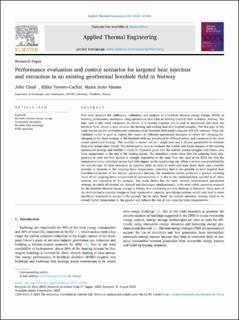| dc.contributor.author | Clauß, John | |
| dc.contributor.author | Taveres-Cachat, Ellika Rose Renee | |
| dc.contributor.author | Justo Alonso, Maria | |
| dc.date.accessioned | 2023-09-18T06:32:51Z | |
| dc.date.available | 2023-09-18T06:32:51Z | |
| dc.date.created | 2023-09-04T08:08:30Z | |
| dc.date.issued | 2023 | |
| dc.identifier.issn | 1359-4311 | |
| dc.identifier.uri | https://hdl.handle.net/11250/3089962 | |
| dc.description.abstract | This work presents the calibration, validation, and analysis of a borehole thermal energy storage (BTES) in building performance simulation using operational data from an existing borehole field in Kalnes, Norway. The data used in this study comprises the results of a thermal response test as well as operational data from the borehole field, which is used to cover the heating and cooling load of a hospital complex. The first part of this study focuses on the calibration and validation of the borehole field model using the IDA ICE software. Then, the validated model is used to explore the impact of different operational strategies in which the charging/discharging of the three sections of the borehole field are prioritized in different orders and compared to the most recent operational strategy. This analysis is carried out on a single year and a 20-year perspective to evaluate long-term temperature trends. This investigation aims to evaluate the current and future impacts of the existing operational strategy and whether it could be improved given that the real-life system struggles with below zero brine temperature at the end of the heating season. The simulation results show that the outgoing brine temperature in each borehole section is strongly dependent on the mass flow rate used in the BTES but that the temperature in an individual section had little impact on the neighboring one. When a section was prioritized by the control logic for heat extraction or injection (both in terms of order and mass flow), there was a notable increase or decrease in the outgoing brine temperature, indicating that it was possible to have targeted heat injection/extraction. In the 20-year operational horizon, the simulation results predicted a gradual warming trend of the outgoing brine temperature of approximately 1 °C due to the additional heat injected in all three sections and regardless of the scenario. The study shows that the most recently implemented operational strategy, in which all sections are charged and discharged simultaneously, is the most viable operation scenario for the borehole thermal energy storage at Kalnes, thus confirming previous findings in literature. Since none of the sections had a superior storage or heat regeneration capacity, prioritizing sections would only lead to more significant temperature swings in the ground. On the other hand, the current operation strategy leads to an overall higher temperature in the ground and reduces the risk of low outgoing brine temperatures | en_US |
| dc.language.iso | eng | en_US |
| dc.publisher | Elsevier | en_US |
| dc.rights | CC BY 4.0 | * |
| dc.rights.uri | http://creativecommons.org/licenses/by/4.0/ | * |
| dc.subject | Borehole thermal energy storage | en_US |
| dc.subject | Geothermal simulation | en_US |
| dc.subject | Borehole field sectioning | en_US |
| dc.subject | BTES operation | en_US |
| dc.title | Performance evaluation and control scenarios for targeted heat injection and extraction in an existing geothermal borehole field in Norway | en_US |
| dc.type | Peer reviewed | en_US |
| dc.type | Journal article | en_US |
| dc.description.version | publishedVersion | en_US |
| dc.rights.holder | © 2023 The authors | en_US |
| dc.subject.nsi | VDP::Teknologi: 500 | en_US |
| dc.source.pagenumber | 14 | en_US |
| dc.source.volume | 236 | en_US |
| dc.source.journal | Applied Thermal Engineering | en_US |
| dc.source.issue | Part A | en_US |
| dc.identifier.doi | 10.1016/j.applthermaleng.2023.121468 | |
| dc.identifier.cristin | 2171904 | |
| dc.relation.project | Norges forskningsråd: 281000 | en_US |
| dc.source.articlenumber | 121468 | en_US |
| cristin.ispublished | true | |
| cristin.fulltext | original | |
| cristin.qualitycode | 1 | |

